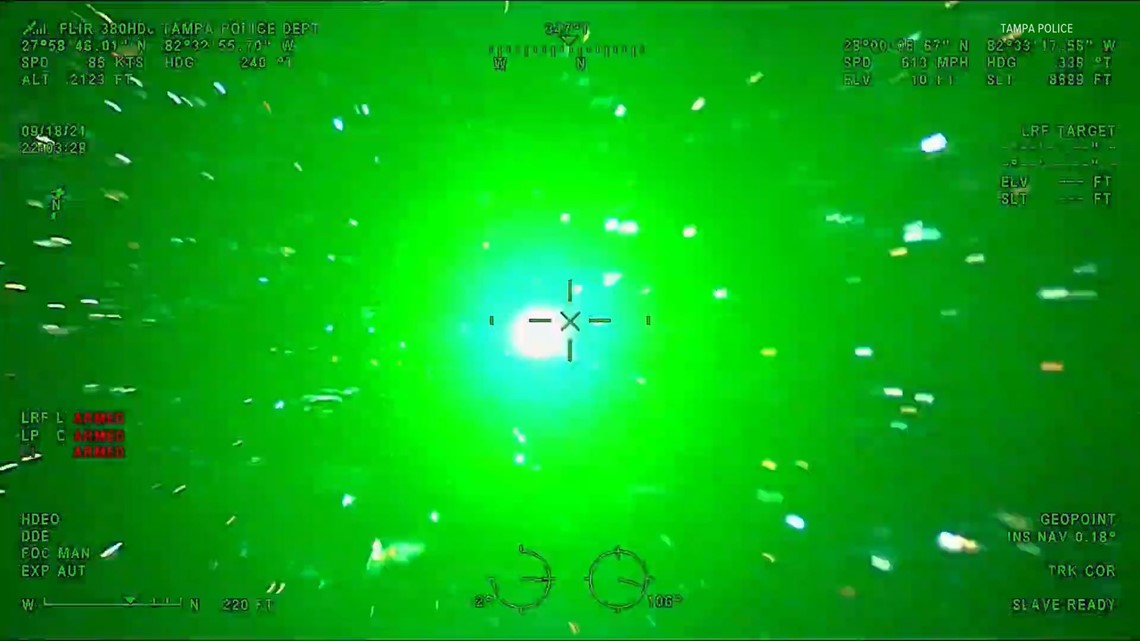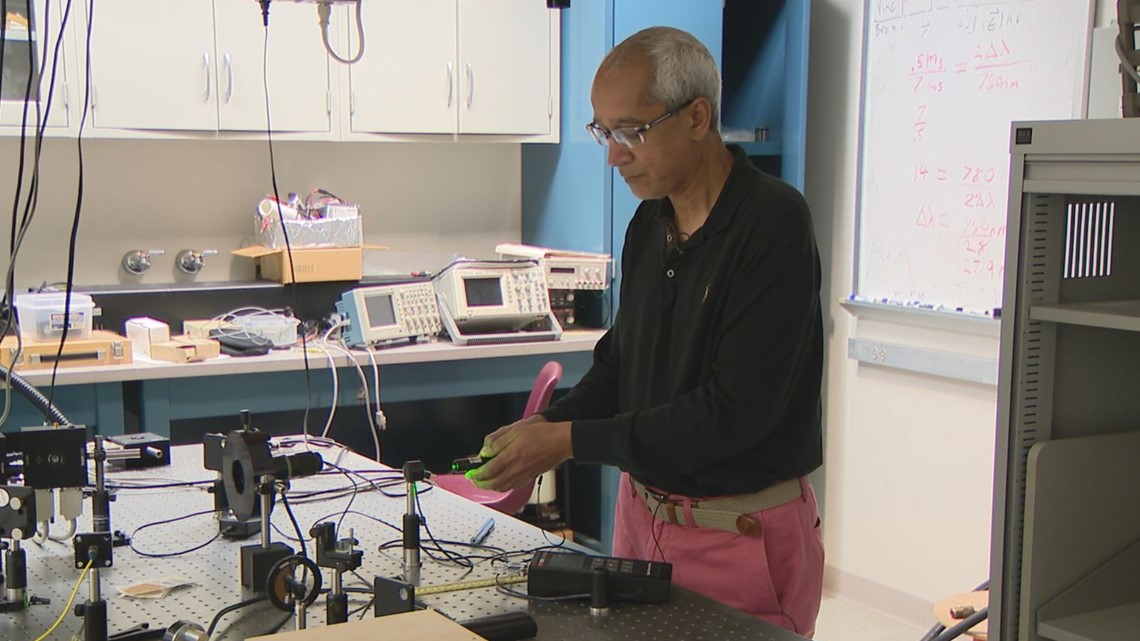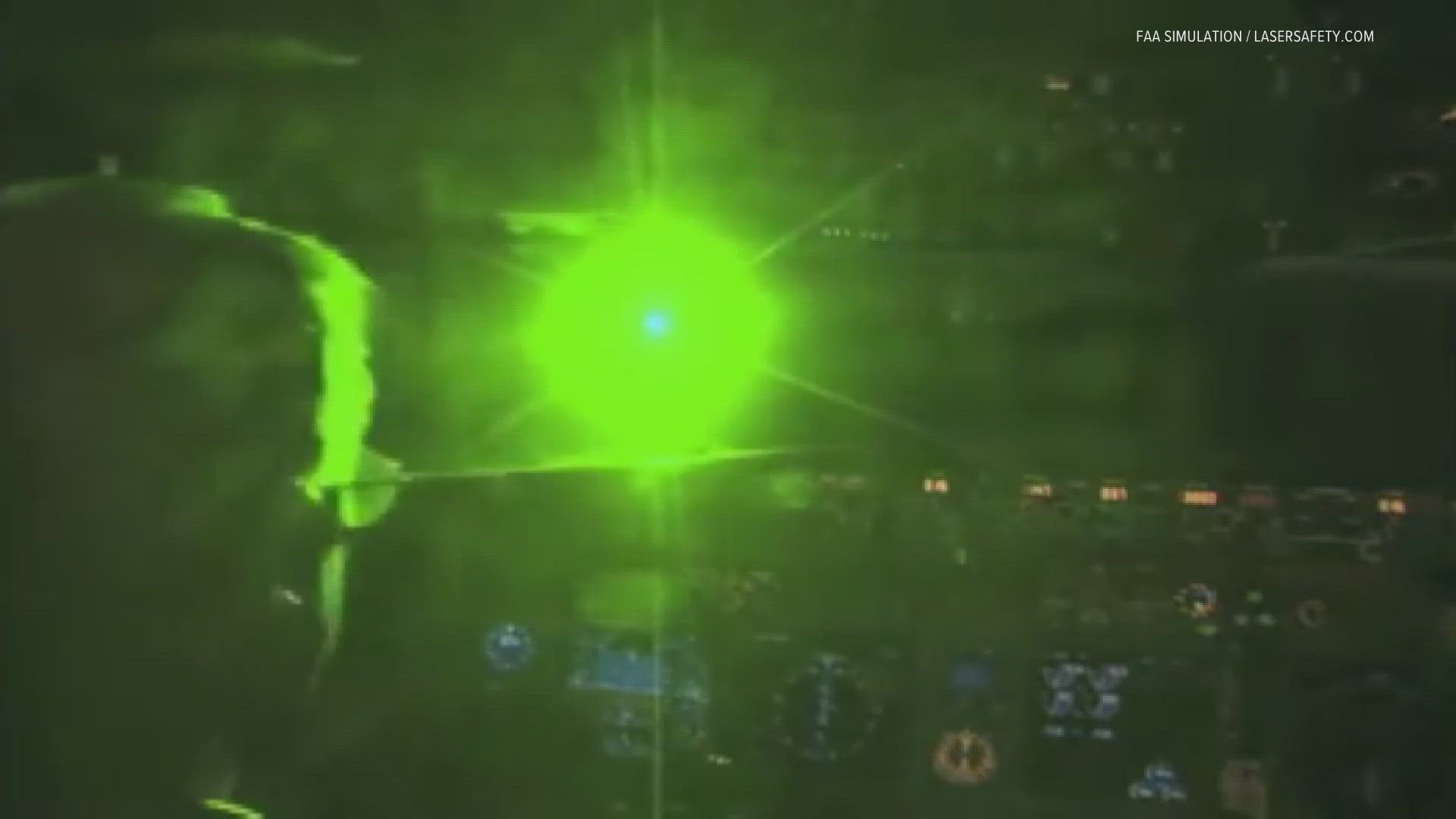INDIANAPOLIS — Carl Thompson still has vivid memories of the night he was hit by a laser while landing a 757 at Indianapolis International Airport.
“Just, 'Boom!' Like that,” he told 13News, abruptly moving his head backward and squinting his eyes. “It was solid and it lit up the whole cockpit green. It was huge, and I just remember screaming at my first officer to land the airplane!”
The now-retired FedEx pilot immediately reported the laser incident to air traffic controllers so they could warn other pilots while his co-pilot safely landed their cargo jet. Thompson said landing the plane on his own would have been challenging - if not impossible - in the moments following the laser strike.
“I couldn’t see. At the time, everything, my eyes just went white,” he recalls. “If that had been me flying that airplane by myself that night, it would've been over, just because of that temporary blindness.”


The 2016 incident is one of more than 87,000 aircraft laser incidents reported by pilots in the United States since the Federal Aviation Administration started tracking the problem in 2004.
Aircraft laser incidents reported in 2023 are on pace to set new records – locally and nationally – putting both pilots and passengers in danger.
Major airlines, carriers report laser hits in Indy
Most laser incidents occur when someone on the ground shines a laser pointer at an in-flight aircraft – an act which is illegal under federal law. Through July, commercial and cargo pilots have already experienced 314 laser strikes in the skies over Indiana, a 40% increase from the same period last year.
American, United, Southwest, Delta, Allegiant, FedEx and UPS are among the airlines and cargo carriers reporting laser incidents while flying in or out of Indianapolis in 2023. Other laser incidents have have been reported in Evansville, Fort Wayne, Gary, Lafayette, South Bend and Terre Haute.
RELATED: Federal jury indicts 4 Georgia men for allegedly aiming laser pointers at police helicopters
The increase in reported laser incidents is happening all over the country.
Over the past five years, the number of annual laser incidents in the U.S. jumped 40% from 6,754 to 9,457, according to data collected by the FAA.
This year’s numbers are skyrocketing even further. Reports collected through July suggest 2023 will see another 40% jump in aircraft laser incidents, with incidents expected to approach 13,000 by year’s end.
“The number of laser incidents involving aircraft unfortunately keeps going up and up,” said Patrick Murphy, a laser expert who tracks laser strikes on his website LaserPointerSafety.com. “People think they can aim a laser at an aircraft and it’s going to be a little tiny dot, but it’s not. It’s a big blob of light by the time it reaches the pilot, and it’s hard for the pilot to see through that.”
So far, there are no reports of an accident involving planes or helicopters targeted by lasers, but Murphy worries it could be only a matter of time before a lased aircraft suffers unfortunate consequences.
“There’s no question these bright lights distract pilots,” he told 13News. “It’s a big deal because you have a laser aimed at an aircract and all of a sudden a pilot cannot see. That’s not what you want when you’re on an airplane and your pilot is trying to land.”
A class 3B laser – readily available online for less than $20 – can distract a pilot from up to 20 miles away, according to FAA data.
It might seem that a beam of light from hundreds or thousands of feet away would be nothing more than a nuisance, but that’s not always the case.
13 Investigates tracked pilot laser reports dating back to 2015 and found at least 285 pilots have reported eye injuries after they were targeted by lasers.
Among the reported injuries are a FedEx pilot hit by a blue laser last year while landing in Indianapolis, an American Airlines pilot who was injured by a green laser while flying into Evansville in 2021, and a Skywest pilot who reported a laser strike over Fort Wayne in 2019.
Most injuries are described as very minor, but others can be quite serious.
Direct hit required two eye surgeries
Thomspson said his aircraft was on final approach to Indianapolis International Airport on a clear night when his cockpit was blasted with a green laser.
“It was very close – right along the fence of the airport – and we were only about 500 feet in the air, so it’s a direct shot when you’re that close,” he said.
The longtime pilot said it took several minutes for the white haze to disappear after he was exposed to the bright green laser. Within minutes, Thompson began experiencing “black floaty things” in his left eye – a medical condition known as floaters that is common after the eye has been exposed to extremely bright light.
His vision soon got worse.
“All of a sudden, I’ve got some black just blanking out part of my eye. It’s just kind of like a half moon coming across my eye,” Thompson explained. He visited an eye doctor as soon as he got home and was referred to an eye surgeon.


Thompson said the specialist operated on his left eye the next morning to repair a tear in his retina. He would later undergo a second surgery to repair laser damage to his right eye, and both operations required months of recovery.
Ten months after being hit by a laser in flight, Thompson was finally cleared to be back in a cockpit full-time. He suspects the laser that damaged his eyes was not simply a strong laser pointer, but rather a type of high-powered laser that pilots usually see only while flying overseas.
“This was like a sun showing up. It took up the whole window frame and lit things up solid,” he said. “I’ve seen them in Paris, in Germany, China. This is the first one of the super high-powered lasers like that I’d ever seen in the U.S.”
$16 “laser pointers” brighter than the sun
Some pilots, scientists and safety advocates say intense lasers that could cause serious eye damage are too easy to get.
13 Investigates bought a $16 laser pointer online. The listing said the Chinese-made item can be seen from a distance of 2,000 meters, referring to the laser pointer as a “green laser toy” that can be used for presentations, astronomy, camping and playing with your pet.


The item arrived in white box embossed with the words “GREEN LASER POINTER” in gold letters. Inside was a 5-inch, black alloy instrument that looks like a small flashlight. Attached to the laser is a label that includes a variety of phrases such as “DANGER, “AVOID EXPOSURE LASER,” “Banned direct eyes” and “Forbid children to play” in tiny letters.
Separate instructions included in the box refer to the item as a “tactical flashlight” and again warn users to keep the laser away from children and not to aim it at the eyes of humans or pets. But the specifications – both online and in the instructions – provide no information about the strength of the $16 laser.
13 Investigates took the laser to an IUPUI physics lab for testing. The initial results were unexpected: the beam of light emitted by the laser was so strong, it overpowered the lab’s testing device, resulting in a reading of “Overload.”
“I was surprised. I was not expecting that, so I have to find another power meter to measure the real power of this device,” said Dr. Gautam Vemuri, an IUPUI physics professor who specializes in lasers.


A separate meter showed the laser’s strength is between 100 and 107 mW (milliwatts). Vemuri said the intensity of that laser is stronger than the sun because the intense beam of laser light is so highly concentrated into a small area.
“This laser would cause significant damage to the eye,” he said. “It’s very, very dangerous. This is definitely not a toy, and I am very, very surprised that they can advertise it that way.”
Many “laser pointers” exceed FDA rules
Dr. Ramana Moorthy is also concerned about lasers being promoted as harmless fun.
The Indianapolis eye surgeon has treated children who have been injured by laser pointers, and he said 100 mW lasers are far too powerful for most purposes.
"Anything over 50 mW of power is likely to cause significant damage to the center of the retina, the macula…They’re super dangerous,” he told 13 Investigates. “I don’t know how an ordinary consumer would want to use these. They are far too powerful for ordinary day-to-day use as a laser pointer.”
Many of the lasers now sold online – including the one purchased by 13News – are not legally allowed to be sold as “laser pointers.” Laser devices that emit more than 5mW of power are considered Class 3B lasers and cannot legally be promoted or advertised as laser pointers due the risk of eye injury, according to the FDA.
They are, however, still legal for sale in the U.S – a reality that some scientists, doctors and pilots are questioning.
“I love lasers and for a long time did not want to see more regulations, but I think we have to have regulations that would ban these stronger lasers and would not allow them in the hands of ordinary people,” said Murphy, the longtime laser expert who has served as a consultant to the FAA.
“Absolutely, there should be some sort of regulations on this and some controls,” added Vemuri, alarmed by the risk of lasers to both pilots and to children.
Laser offenders face penalties
Easy access to lasers is, in part, fueling the large increase in aircraft laser incidents, according to the FAA. The federal agency sent 13News a statement, attributing the higher numbers to:
- The availability of inexpensive laser devices
- The abundance of lasers for sale in stores and online
- The number of lasers being given as gifts
- Stronger power levels that enable lasers to hit aircraft at higher altitudes
- Green lasers, which are more visible to the human eye than red lasers
- Greater awareness by pilots to report laser incidents
Who would point a laser at a pilot in flight?
Thompson, who retired from FedEx in 2021, has been wondering about that for years.
“That’s the question that everybody asks me,” he said. “Could it be a bunch of kids out playing? I’m sure some of that happens. Some of it’s just they honestly want to see if they can bring an airplane down.”
He said one of his FedEx colleagues reported seeing a drone flying near his plane that appeared to be following the aircraft and trying to shine a laser at the cockpit.
“Indy has a higher than normal rate of laser events. Pilots there see a lot,” Thompson said.
Indiana does have one of the highest per capita aircraft lasing rates in the nation, according to the FAA.
Murphy said offenders fall into two categories. “The first is just ordinary citizens like you and me thinking they’ll go in the backyard, aim their laser at a plane, and they don’t realize the hazards,” he said. “The other is people with criminal intent or people who are just antisocial – those who want to aim a laser at the plane because they want to ‘stick it to the man,’ they don’t like the noise or have harmful intent.”


Pointing a laser at an aircraft is a federal crime with penalties of up to $11,000 per incident and up to five years in prison.
Occasionally, offenders are arrested, and there are multiple convictions for aircraft lasings in states like Florida and California. But most offenders are never caught because tracking them without a police helicopter and ground support is very difficult.
Despite the low arrest rate, Thompson has a message for anyone even considering pointing a laser at a plane.
“Don’t freakin' do it,” he said. “You may kill somebody or a bunch of people and you may up in federal prison.”
FAA wants your help to catch laser suspects
The FAA encourages pilots and the public to report aircraft laser incidents immediately.
If you witness someone aiming a laser at an aircraft, the agency requests that you send an email to laserreports@faa.gov and include the following information:
- Your name and contact information
- Date and time you witnessed the laser incident
- Location and description of the incident
The FAA also offers the following resources about laser strikes on airplanes:
- FAA laser strike fact sheet
- Video to learn more about the dangers of laser strikes
- FAA visualization tool to see where laser strikes are happening
- Laser strike data by year
- City and state laser strike data

